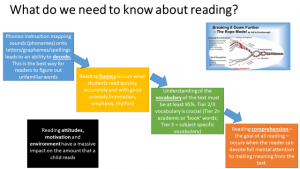
| Reading for all at The Heights, Burnley | |||
| Targeted Intervention | Universal Offer | ||
|
Additional support for the weakest readers |
Reading for pleasure |
English Curriculum |
Wider Curriculum |
| Reading concerns
· Diagnostic Reading Assessment · Close monitoring through Accelerated Reader · Specific interventions including: phonics, fluency, comprehension and reading for pleasure. · Dedicated KS1 and 2 phonics programme. · Dedicated KS3 and KS4 phonics programme. · Quality First Teaching strategies- teachers made aware of these pupils. |
Accelerated Reader
· Access to the school library Culture of reading · Reading recommendations from every teacher ‘I am reading posters’. Quality resources · Well stocked and maintained library with a dedicated TA. · Recommended reading lists · Reading events including WBD. · Book Buzz so that all pupils have access to reading materials.
|
Carefully chosen texts to increase background knowledge
· Novels, poetry and non-fiction texts within the English curriculum. Curriculum Thinking Documentation · Key reading knowledge revisited. · Vocabulary taught via the SEEC model. Library lessons · KS3 pupils access library lessons and select their own reads.
|
Vocabulary instruction
· Key vocabulary taught using Alex Quigley’s SEEC model. Oracy · Modelling of reading by teaching staff Staff CPD · INSET and regular CPD focus for all teachers and support staff.
|
At The Heights, Burnley reading is prioritised throughout our school and is an integral part of the daily routine. Our whole-school approach includes:
- At Year 9, 10 and 11, we use a Diagnostic Reading Analysis for pupils who need urgent interventions with comprehension, fluency and phonics.
- We use the Accelerated Reader reports to reveal how much a student has been reading, at what level of complexity, and how well they have understood what they have read.
- For KS1 and KS2 we use the Read, Write Inc. Phonics screening programme daily during lessons.
- We also use IDL as a literacy improvement tool, this digital platform is used to practise phonics, spelling, punctuation, sentence and reading skills at a level appropriate to a pupil’s own ability.
- This data allows the school to implement swift interventions, which run for a full term and is collected via the library and The Link and the impact of the intervention is measured.
- Weak readers receive additional support and interventions immediately with reading and literacy:
- Reading interventions are identified by the Reading Lead, who collaborates with the Senco to ensure interventions are timetabled and monitored.
- Reading interventions are facilitated in The Link (SEND) and the library and impact is measured half termly.
At Key Stage 1 and 2 we use the ‘Read, write Inc’ phonics programme, staff have received external CPD to ensure they are fully trained.
We also offer phonics based interventions at Key Stage 3 and 4 for those pupils identified.
- Staff have accessed extensive CPD for reading including; how to model reading, being a role model for reading, guided reading and pre-teaching vocabulary using the SEEC model.


